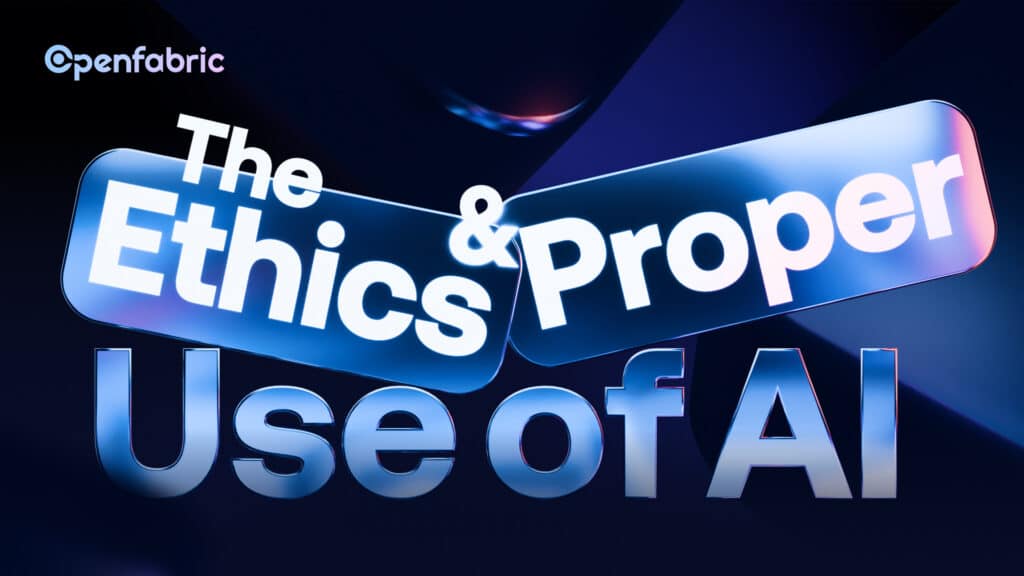
October 25, 2024 5 minutes read
The Ethics and Proper Use of AI

Artificial intelligence has gained a widespread adoption in the world today. Hardly anything is done without incorporating AI. This has many general and specific benefits to various industries. However, with this widespread adoption, misuse is also bound to happen. This is why AI experts created ethics that oversee the proper use of AI. These ethics do not only govern the proper use of AI, they also guide the development and implementation of AI.
AI ethics are the basic moral principles that govern the creation, implementation and proper use of AI. This is necessary because we need to create a world of AI that is fair, unbiased and safe to use. In this article, we will be discussing the ethics and the proper use of AI technology.
Let’s get started!
What are the ethics of AI?
Ethics of AI are the ideas and rules that ensure that the creation, distribution, and application of AI systems are consistent with human values. These include fairness, transparency, accountability, and respect for human rights. It entails assessing the potential effects of AI on persons, society, and the environment, as well as resolving issues like bias, privacy, security, and autonomy.
Why AI ethics?
The implementation of Artificial Intelligence is widespread in different industries. However, this has raised public concerns on how it affects society. Developers and users need to recognize the real world consequences of AI because AI can go wrong. For example, concerns about facial recognition systems for being racially bias have been raised recently. This has led to wrongful arrests and poor execution of justice. Also, poorly designed chatbots can spread misinformation and harassment. Recently, a mother in Florida has accused an AI company for contributing to the suicide of her teenage son which led to a lawsuit action against the company. This only reinforces the pressing need for the ethics of AI that are centered on protecting human values.
In response to the arising issues, the United Nations Educational, Scientific and Cultural Organization (UNESCO) came up with the pioneer global standard on AI ethics. It is known as the ‘Recommendation on the Ethics of Artificial Intelligence’. This document contains ethics that are based on protecting human rights and dignity.
There are 10 core human rights approaches which the AI ethics are based on. These include:
- Proportionality and Do No Harm: AI systems must only be used to the extent required to accomplish a justifiable goal. Risk assessment should be performed, periodically, to avoid potential hazards that may arise from such applications.
- Safety and Security: AI actors should prevent and fix both unwanted damages (safety risks) and security risks.
- Right to Privacy and Data Protection: Throughout the lifespan of the AI, privacy must be safeguarded and frameworks for adequate data protection be put in place.
- Multi-stakeholder and Adaptive Governance & Collaboration: The use of data must be consistent with international and national laws. Furthermore, for more inclusive approaches to AI governance a diverse range of stakeholders must be involved.
- Responsibility and Accountability: Artificial intelligence systems should be auditable and traceable. To avoid conflicts with human rights norms and dangers to environmental well-being, there should be processes for implementing oversight, impact assessment, auditing, and due diligence.
- Transparency and Explainability (T&E): The ethical deployment of AI systems is dependent on their transparency and explainability (T&E). The level of T&E should be appropriate for the circumstances. This is because T&E may conflict with other principles such as privacy, safety, and security.
- Human Oversight and Determination: Member states should ensure that AI systems do not take away basic human duty and accountability.
- Sustainability: The effects of AI technology should be evaluated based on “sustainability”. This is a set of objectives that change always, such as the Sustainable Development Goals of the UN.
- Awareness & Literacy: Open and accessible education, civic engagement, digital skills and AI ethics training, as well as media and information literacy should be used to increase public knowledge of AI and data.
- Fairness and Non-Discrimination: AI should support social justice, fairness, and nondiscrimination while heading towards an inclusive approach to ensure that the positive benefits of AI are available to all.
What then is the proper use of AI?
There are many uses of AI. The use of AI depends on the industry or the problem it was meant to solve. However, there are basic uses that are considered as the proper use of AI. They help guide you, the user, on how to positively use AI.
They include:
- Text-based uses such as copywriting.
- Generation of images
- Summarization of long form texts
- Retrieving information from the internet
- Using ChatBots for conversations
- AI assistants in homes and for devices
- Writing and improving code
- For online transactions and other financial services such as trading.
These are the most common uses of AI widely known. Other uses such as crime detection, manufacturing and facial recognition are common industrially.
For a proper use of AI, one must remember that the information obtained may not be very accurate. Hence, every information obtained must be verified before using. Understanding the limitations of AI can help us achieve more with it and create room for further improvement.
Embracing the Ethics of AI at Openfabric AI
At Openfabric AI, we understand how importance of adhering to core human values. This guides the development of our AI tools all available on our PLATFORM.
Openfabric AI is designed with transparency at its core. This is key in the decision making process that precede the development of our AI tools to ensure trust and accountability. This level of transparency helps our users identify any bias and errors, if present.
Furthermore, our AI solutions are designed to support human efforts, not replace them. Therefore, we adopt a human-focused approach in the development of our AI tools to align with human values and rights.
As the ethics of AI continue to develop, we are continuously improving and refining our processes to accommodate this change.
Stay updated with our recent developments on our WEBSITE.
Conclusion
The conversation about the ethics and proper use of AI is one that is still ongoing. However, in the development and use of AI, we must respect human rights and values. Only then can we begin to see the impact and future of AI in our society. As we begin to see a wide adoption of artificial intelligence, we must also ensure that we use AI properly to protect ourselves and other users. We must remember that AI is not human and it has its limitations. The only way to overcome these limitations is by the integration of AI with human emotional intelligence. By doing so, we will be able to fully explore what AI can do.
Visit our WEBSITE to explore all our AI tools and resources.

